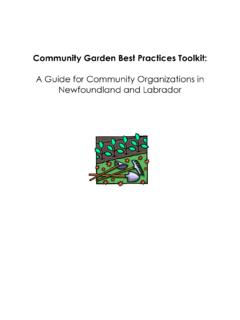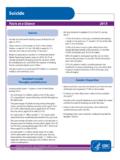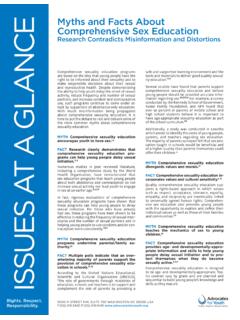Transcription of A Guide for Community Organizations in Newfoundland and ...
1 Community kitchen best practices toolkit : A Guide for Community Organizations in Newfoundland and Labrador 1 Prepared by Kristen Lowitt for the Food Security Network of Newfoundland and Labrador In collaboration with the Poverty Reduction Division, Department of Human Resources, Labour and Employment and the Health Promotion & Wellness Division, Department of Health and Community Services Updated May, 2011 2 Table of Contents Preface .. 4 Acknowledgements .. 5 Introduction .. 6 What is a Community kitchen ? .. 6 Why Start a Community kitchen ? .. 6 Getting Started: Steps for Success .. 7 Step 1: Identify a Group .. 7 Step 2: Find a Coordinator .. 8 Step 3: Establish Partnerships .. 9 Step 4: Find a Location.
2 10 Step 5: Look for Funding and Sponsors .. 11 Step 6: Hold a kitchen Orientation Meeting .. 13 Step 7: Obtain Supplies .. 14 Step 8: Hold Your First Community kitchen .. 14 How to Lead a Community kitchen .. 15 Planning .. 15 Shopping .. 18 Cooking .. 20 Healthy Eating .. 22 Canada s Food Guide .. 22 Key messages from Canada's Food Guide .. 22 Canada s Food Guide for First Nations, Inuit and M tis .. 23 Healthy Eating Lessons .. 23 24 Recipe Analyzer Tool .. 24 Local Foods .. 25 Desserts .. 25 Using Recipes in the 25 Food Safety .. 26 Evaluation .. 28 Appendix A: Are You Ready? Checklist .. 29 Appendix B: Community kitchen Flyer .. 30 Appendix C: Adult Learning Principles .. 31 Appendix D: kitchen Equipment List .. 32 3 Appendix E: Incorporation for Non-Profit Organizations .
3 33 Appendix F: Member Registration Form .. 34 Appendix G: Sample kitchen Policy .. 35 Appendix H: Basic kitchen Supplies .. 36 Appendix I: Shopping List for Recipes .. 37 Appendix J: Food Safety Guidelines .. 38 Appendix K: Plan Your Healthy Plate .. 40 Appendix L: Portion Control .. 41 Appendix M: Food Labels .. 42 Appendix N: Making Recipes Healthy .. 44 Appendix O: Sample Evaluation Form .. 45 Appendix P: Pre-Test Community kitchen Evaluation Form .. 46 Appendix Q: Post-Test Community kitchen Evaluation Form .. 47 Appendix R: Important Links and Resources .. 48 Annotated Bibliography .. 52 4 Preface This toolkit is designed to assist Community Organizations in Newfoundland and Labrador in starting a Community kitchen . It outlines key steps to starting a kitchen , and provides a range of tools and support materials to help you along the way.
4 This toolkit is based on best practices research about Community kitchens. best practices were identified through a review of existing reports, resources, and guides on Community kitchens in Canada, with particular attention to resources from Newfoundland and Labrador. The bibliography at the end of this toolkit lists the materials consulted in this review. This research was enhanced by consultations with Community kitchen leaders and organizers from across Newfoundland and Labrador and elsewhere in Canada. The research, development, and writing of this toolkit was completed by Kristen Lowitt on behalf of the Food Security Network of Newfoundland and Labrador. This toolkit is one in a series of best practices toolkits, which also cover Community gardens, farmers markets, and bulk buying clubs, available through the Food Security Network of Newfoundland and Labrador.
5 5 Acknowledgements The author would like to thank everyone who participated in consultations and focus groups, as well as those who provided important feedback on earlier drafts of this toolkit . A special thank you to: Maxine Boyde, Program Director, Salvation Army New Hope Community Centre, St John s, NL Stephanie Buckle, Regional Nutritionist, Western Health, Corner Brook, NL Margaret Coombes, Regional Nutritionist, Eastern Health, St John s, NL Suzanne Galesloot, Nutrition Services, Alberta Health Services Kelly Janes, Health Promotion and Wellness Coordinator, Labrador-Grenfell Health, Goose Bay, NL Laurie Pinhorn, Program Coordinator, Naomi Centre, Stella Burry Community Services, St John s, NL Yvette Walton Single Parent Association of Newfoundland , St John s, NL Jill Wheaton, Regional Nutritionist, Central Health, Gander, NL Photo contributions: Page 21.
6 Community kitchen in Gander, Central Health Page 27: Community kitchen in Gander, Central Health The author would also like to thank the advisory committee for this project: Glendora Boland, Department of Health and Community Services, Health Promotion and Wellness Division Stephanie Buckle, Western Health Barbara Case, Rural Secretariat Sarah Frank and Linda Hillier, Labrador-Grenfell Health Douglas Howse, Department of Health and Community Services, Public Health Division Melodie Kelly, Department of Human Resources, Labour, and Employment, Poverty Reduction Strategy Dena Parsons, Department of Natural Resources, Forestry and Agrifoods Agency Editing support was provided by staff of the Food Security Network NL, including.
7 Kristie Jameson, Executive Director Rick Kelly, Communications Coordinator Janna Rosales, Project Support Sarah Ferber, Project Coordinator 6 Introduction What is a Community kitchen ? Community kitchens (also called collective kitchens ) are Community -based cooking programs where small groups of people come together to prepare meals and take food home to their families. In a Community kitchen every member contributes by planning, preparing, and cooking food. Community kitchens are great opportunities for learning about the importance of healthy eating and developing the skills to prepare healthy and affordable meals. Why Start a Community kitchen ? A Community kitchen can help improve food security for participants by increasing physical and economic access to adequate amounts of healthy food.
8 By being involved in a Community kitchen , participants can: Learn how to prepare healthy, tasty and nutritious meals on a budget Develop food knowledge and cooking skills Learn to plan meals using Canada s Food Guide Become more skilled in budgeting and shopping Save money on food by learning cost-effective shopping skills Try new foods Take home tasty and nutritious meals Learn how to read food labels Build confidence cooking and feel more comfortable in the kitchen Cook in a social atmosphere and meet new friends! Did you know? Research shows that Community kitchens can have positive impacts on social support networks, education, and personal health practices . 7 Getting Started: Steps for Success There are many different models of Community kitchens and although there is no one best way to start a kitchen , the following is a list of steps your organization will want to consider when starting your own Community kitchen .
9 Appendix A: Are you Ready? Checklist (page 29) provides a checklist based on the following steps. This will allow you to evaluate your readiness when starting a Community kitchen . Step 1: Identify a Group The first step is to identity a group of people that your Community kitchen will serve. Many Community Organizations already have a group of participants who can join a kitchen , such as single parents, a youth group, the elderly at a senior s complex, or members of a church. Keep in mind that the ideal size for a Community kitchen is usually between four to eight participants. If you do not already have a group, you will need to recruit participants. It is a good idea to hold a Community meeting to discuss the idea of a Community kitchen and recruit participants.
10 Appendix B: Community kitchen Flyer (page 30) provides a sample flyer that you may use to advertise your Community meeting, promote the kitchen , and find participants. Take the time to get to know the group you will be working with and think about how you will design and structure your kitchen to meet your participants unique needs and circumstances. For example, if your Community kitchen is for single parents, you will want to design a cooking schedule that takes into account their work and child-care schedules, and prepare meals that are appropriate for them to take home to their children. Remember Many participants will be cooking for several family members, so the number of mouths to feed will be greater than the actual number of people in the kitchen .








